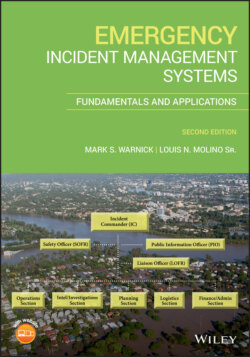Читать книгу Emergency Incident Management Systems - Mark Warnick S., Louis N. Molino Sr - Страница 43
1.15 Conclusion
ОглавлениеComparatively speaking, emergency incident management is a relatively new concept that was formally conceived within the last 60 years (or thereabouts), even though portions of incident management systems have been used hundreds of years. Current Incident Management Systems are a powerful tool for first responders, providing that they are used and used properly. In order to be a successful in your organization and to be a useful tool, IMS methods must be and remain, comprehensive, flexible, and adaptable.
Changes have been made to all types of Incident Management Systems since the inception of FIRESCOPE. While many versions have been created and used, it is important to note that the standard for incident management in the United States is NIMS. The use and mandate of NIMS is applicable at all jurisdictional levels and across all disciplines.
As was mentioned previously, NIMS is applicable across a full spectrum of potential incidents, hazards, and impacts, and is flexible enough to provide command and control of incidents regardless of their size, location, or complexity. This bears repeating because as users of NIMS, we need to be cognizant of why we utilize the NIMS method in the United States, instead of some other IMS method.
NIMS goes the extra step and goes beyond integrating first responders; it improves coordination and cooperation between public and private entities in an assortment of incident management activities. The NIMS method is designed to cover cascading events, but it is flexible enough to transcend jurisdictional boundaries. It allows for an incident management system that can be used to cover large areas, or even across state boundaries, or just the small local incident. The overall method provides a common standard to anyone who may be involved in the overall incident management. It encompasses all facets of mitigation, preparedness, response, and recovery both manmade and natural disasters as well as planned events. A more thorough explanation will be provided in Chapter 5, but emergency personnel in the United States need to realize that NIMS is the standard we must use and meet.
If different public safety agencies are expected to work together, a command system for managing people, resources, and equipment is necessary to create a successful outcome. This holds true regardless of how large, small, complex, or simple that incident may be. Use of the National Incident Management Systems allows integration of resources with both speed and efficiency.
It is also important to realize that in order for any IMS method to be truly useful and successful, the system must be implemented from the “top down” and the “bottom up” simultaneously. As we move forward, the use of ICS, NIMS, or any other method of incident management will not be effective unless we utilize and practice it on a regular basis. If you take this tool and hide it in the toolbox while waiting for the “big one” (a large‐scale incident) to occur, you are hurting yourself, your agency, and most importantly the community you serve. If this amazing tool is not taken out of the toolbox and used regularly, it is very likely that when you do need this tool, it will probably be rusty, and the user will probably have problems trying to remember how to use it.
